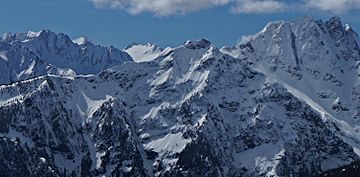Styloid Peak facts for kids
Quick facts for kids Styloid Peak |
|
|---|---|

Styloid Peak seen from Ruby Mountain
|
|
| Highest point | |
| Elevation | 6,972 ft (2,125 m) |
| Prominence | 412 ft (126 m) |
| Parent peak | Distal Phalanx 7620 ft |
| Geography | |
| Location | North Cascades National Park, Washington, U.S. |
| Parent range | North Cascades Cascade Range |
| Topo map | USGS Ross Dam |
| Climbing | |
| First ascent | 1981 John Roper and party |
Styloid Peak is a tall mountain in North Cascades National Park in Washington state. It stands about 6,972 feet (2,125 meters) high. This mountain is located in Skagit County.
Styloid Peak is close to other mountains. Its closest taller neighbor is Mantis Peak, which is about 0.33 miles (0.53 kilometers) to the west. Another mountain, Snowfield Peak, is about 1.7 miles (2.7 kilometers) west. Rain and melting snow from Styloid Peak flow into Neve Creek and McAllister Creek. These creeks then join Thunder Creek.
The first time people climbed to the top of Styloid Peak was on May 31, 1981. A climber named John Roper and his team made this first ascent. On the same day, they also climbed a nearby peak called Distal Phalanx. John Roper was a doctor, and he often named the mountains he climbed after parts of the human body.
Mountain Weather: What to Expect
Styloid Peak is in a special weather area called the marine west coast climate zone. This means it gets a lot of moisture from the ocean. Most of the weather systems that bring rain and snow start over the Pacific Ocean. They then travel northeast towards the Cascade Mountains.
When these weather systems reach the North Cascades, the tall mountains force the air upwards. As the air rises, it cools down and drops its moisture. This process is called orographic lift. Because of this, the western side of the North Cascades gets a lot of rain or snow. This is especially true during the winter months.
In winter, the weather is often cloudy. But in summer, high-pressure systems over the Pacific Ocean usually bring clear skies. The ocean's influence also means that the snow tends to be wet and heavy. This can lead to a high risk of avalanches, which are large slides of snow down a mountain.
How Styloid Peak Was Formed
The North Cascades area, where Styloid Peak is located, has very rugged and dramatic landscapes. You can see sharp peaks, tall spires, long ridges, and deep valleys carved by glaciers. These amazing features were created by geological events that happened millions of years ago. These events caused huge changes in the land's height and led to the different climates we see today.
The story of the Cascade Mountains began millions of years ago, during a time called the late Eocene Epoch. At that time, the North American Plate was slowly moving over the Pacific Plate. This movement caused many volcanic eruptions and created new rock.
Also, small pieces of the Earth's outer layer, called terranes, crashed into North America. These pieces came from the ocean and other continents. These collisions helped build the North Cascades about 50 million years ago.
Later, during the Pleistocene period, which started over two million years ago, huge sheets of ice called glaciers moved across the land. These glaciers advanced and then melted back many times. As they moved, they scraped away the landscape, leaving behind piles of rock. The river valleys in the area have a "U" shape. This shape is a clear sign that glaciers once moved through them.
The combination of the land being pushed upwards (called uplift) and cracks forming in the Earth's crust (called faulting), along with the action of glaciers, are the main reasons why the North Cascades has such tall peaks and deep valleys.



